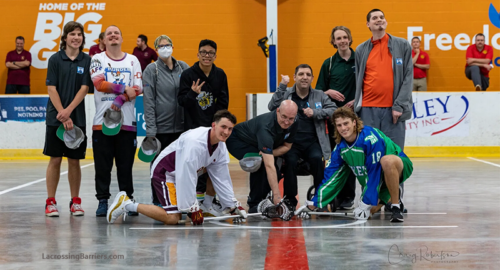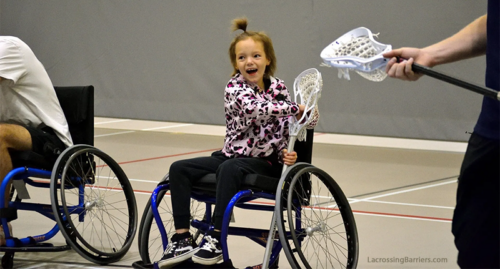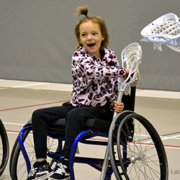Lacrossing Barriers breathes new life into Indigenous sport with accessible programming
 Instead of focusing on why you can’t do something, why not focus on how you can?
Instead of focusing on why you can’t do something, why not focus on how you can?
For Scott Godfrey, the founder of the innovative program Lacrossing Barriers, there’s absolutely no reason why people with intellectual or physical disabilities shouldn’t be given a chance to play competitive lacrosse with their friends – whether they’re on the autism spectrum, use a wheelchair, or have an amputated limb. His approach is to adapt the sport so every participant can be included.
“What we do is create programs that are reverse-engineered. We put everything in the shopping cart that you need to play lacrosse, and we follow the roadmap. Then, like a pothole in the road, which is a detour or distraction, if you have a physical, emotional, neurological or social challenge then we’ll work with that,” he told Sport for Life, after presenting at the 2023 Summit in Calgary.
The program initially grew out of the Autism Aspergers Friendship Society of Calgary, which Godfrey began volunteering at in 2010. Having competed on the men’s lacrosse national team for the 1994 World Cup, and having played the sport since he was a small child, it just made sense for him to share his passion. In 2015 he started a six-week program for seven participants, and it quickly grew exponentially until it was being run for over 32 weeks a year with 20 to 25 players.
“Lacrossing Barriers is a group dedicated to providing the opportunity to play sport to people who haven’t always been given the choice. So we started with a group that was predominantly on the autism spectrum, or that was their primary diagnosis. Now about 70% of our staff are on the spectrum,” he said.
“Then one of the members said to me, two years ago, ‘we should teach people in wheelchairs’ and I said ‘can I ask why?’ Meghan, my oldest daughter, passed away in August 2020 and she was in a wheelchair, so the member said ‘she’s in heaven and I miss her, and I think more people in wheelchairs should play because I like playing catch with people in wheelchairs’.”
From that point on, multiple players in wheelchairs became involved. And though the game has been adapted, the essence of it remains the same.
“In the end, we absolutely maintain standards of safety, respect, and the rules and history of the game. We’re not going to change lacrosse. We’re going to modify it and adapt it.”
But it’s still important to retain the competitive element of the sport.
“We level the playing field in a way that’s respectful and consensual, because if you’re playing and you’ve got an athletic background you’re not going to like it if there’s no competition. Then there’s no spirit of sport. So we make sure that competition is still there, no matter who’s playing.”
A key part of the program is teaching skills like sportsmanship, and giving the players the chance to be competitive while learning that winning isn’t everything.
“We want to make sure that people have the chance to win and lose, and not be defined by wins and losses. You tell them ‘you’ve worked hard and you’re improving’ and guide them to the fact that it’s okay to be mad when you lose, but it’s not okay to stay angry,” he said.
“We teach them those lessons that who they are is not defined by a wheelchair or a neuromuscular disorder or an amputation, that they just have to work together and be friends and teammates and enjoy the game. It’s about allowing people to find their courage, allowing them to be brave.”
Respecting Indigenous history
Lacrosse is a game that Godfrey first learned from his father, and he’s aware of the significance it has in Indigenous culture. He tries to pass that reverence on to his players, making sure they understand its unique history.
“From the time I even heard the word ‘lacrosse’, my Dad was wonderful about sharing the history with me and teaching me how to care for the wooden stick and showing me what it meant,” he said.
“Last year we went to Ontario and visited the Six Nations of Grand River territories. We took time and we were very privileged to have some traditional teaching about the Haudenosaunee Confederacy and about the game. For me it’s always been hand in hand, that if you don’t teach people about that history then you’re not really teaching lacrosse.”
Godfrey makes a point to mark the National Day of Truth and Reconciliation each year, and brings in a group to demonstrate traditional Indigenous dancing and explain why it’s done. He’s honoured by the relationships that his program has built with Six Nations.
“It’s a foundational part of it for me, who would present as a bald white male, to go out to the Siksika Nation outside Calgary and be allowed to facilitate and help collaborate on an adapted lacrosse program. That was humbling and I’ve actually become very close friends with some of the people there. There was an instant connection and we stayed involved. Those in the community are very strong supporters of making sure we’re getting more people playing,” he said.
A vision for the future
Now that Lacrossing Barriers has proven to be a success, Godfrey has big ambitions for how to expand the program and introduce his participants to new sports. He’s teamed up with organizations such as the Centre for Newcomers and Mount Royal University to explore activities like rock-climbing, rugby and boxing.
 “We are going to be running and adapting a climbing program with Mount Royal University, and then in the winter we’ll do wheelchair climbing. Because if you’re harnessed and on belay, there’s safety. And with wheelchair boxing or adapted boxing, it’s for people who wouldn’t necessarily think boxing is for them,” he said.
“We are going to be running and adapting a climbing program with Mount Royal University, and then in the winter we’ll do wheelchair climbing. Because if you’re harnessed and on belay, there’s safety. And with wheelchair boxing or adapted boxing, it’s for people who wouldn’t necessarily think boxing is for them,” he said.
“But we’ve seen videos with people that use boxing as a fitness and skill thing, and they’re in a wheelchair using hand-eye coordination and cardiovascular work and there are all of these health and life benefits. Sometimes people misunderstand how two people in wheelchairs could box, but I never say never. It’s about fitness and accuracy and socializing.”
Another thing they’re trying to encourage is for participants to become certified as coaches in various sports.
“Some of our members aren’t the best readers, and there are others that have dyslexia, so it’s about finding out that they may not know what six is, but they know what half a dozen is. So it’s about breaking down barriers of perceptions or learning uniqueness,” he said.
“We have one guy who wants to coach mainstream rugby and he’s getting over the hurdle of getting tackled, so that’s his journey and we’ll support him if he just wants to play touch rugby and encourage him, show him how much fun it is.”
For all the coaches, he feels it’s important they support each players’ personal journey.
“If you present a sport and then provide the skill, it teaches the player about themselves. It teaches them about the wonderful history of sport. It teaches them that someone has the right to knock the ball out of your stick during a drill. So it teaches them about skill and growth, and it teaches them about consequence,” he said.
“It creates that camaraderie that shows players that we’re all in this together, and when you’re on the field you love each other and you’re friends. It’s the game, and this game is just beautiful.”
To learn more about the Lacrossing Barriers program, click here.


